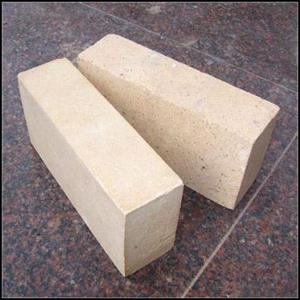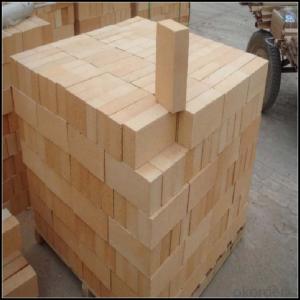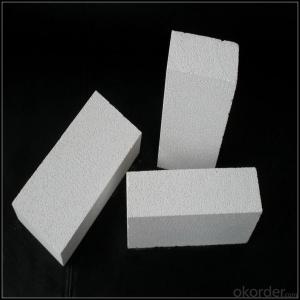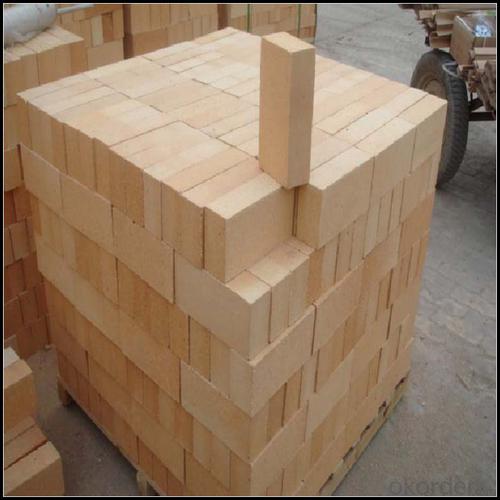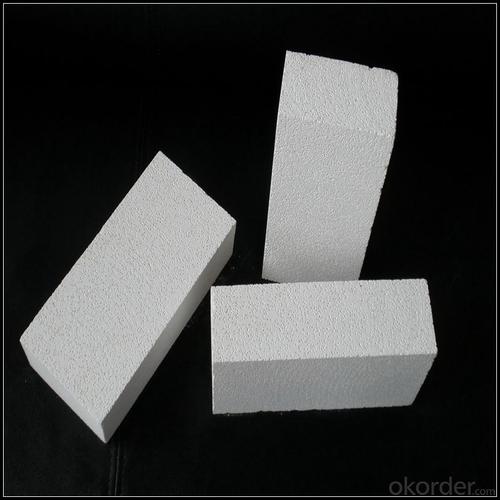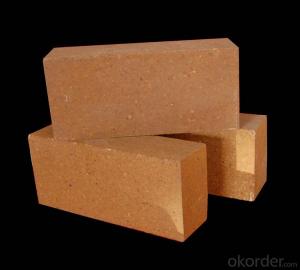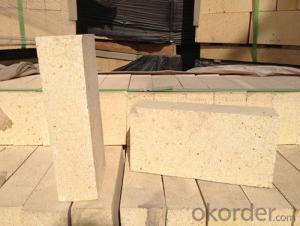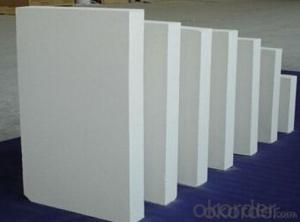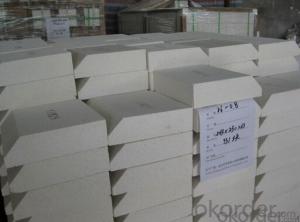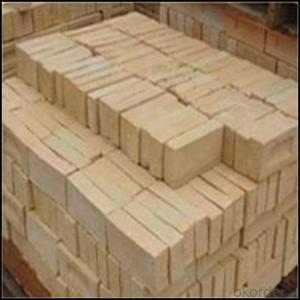Insulating Fire Brick High Alumina Brick for Pizza Oven
- Loading Port:
- China main port
- Payment Terms:
- TT OR LC
- Min Order Qty:
- 2 m.t
- Supply Capability:
- 1000 m.t/month
OKorder Service Pledge
OKorder Financial Service
You Might Also Like
Refractory Brick
CMAX firebricks are classified under temperature between 1300℃ to 1700℃, manufactured from high purity alumina clay by mixing, press-forming, drying, sintering and machining. Bricks contain carefully-graded organic fillers which are burned out during sintering to give a uniform controllable pore structure. This technique makes product feature low thermal conductivity and excellent heat insulation
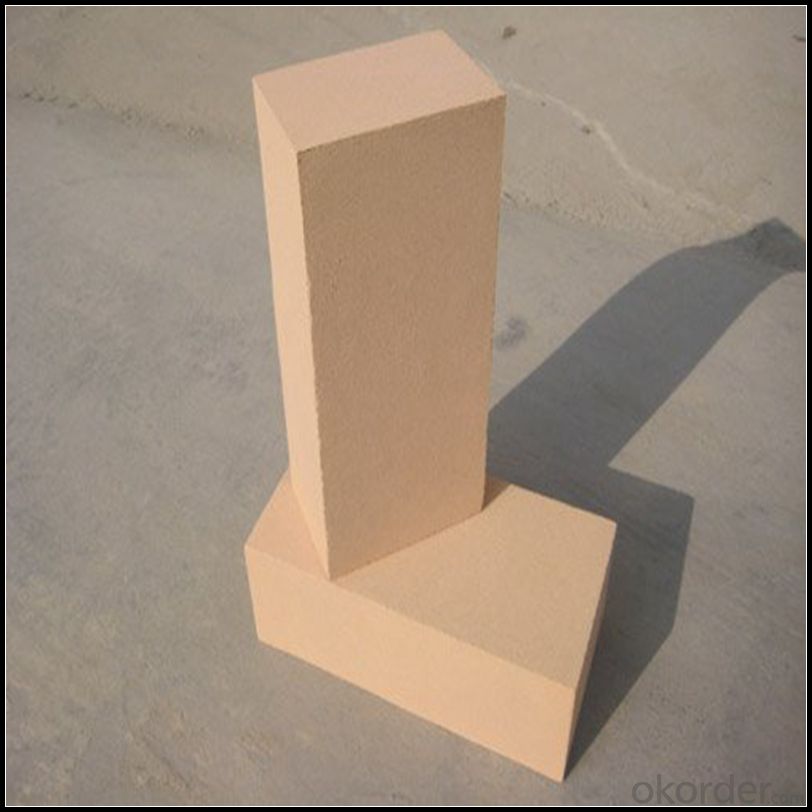
Features
Fireclay refractory brick is a main species of Aluminum silicate product, which adopt clay clinker as raw material, fireclay as bonding agent, the Al2O3 content from 30%~48%.
The refractoriness of Fireclay refractory brick from 1580 to 1770℃, which vary with the ratio of Al2O3 and SiO2
The fireclay refractory brick is faintly acid, whose acidity increasing with the content of SiO2 increasing, which has a certain resist erosion ability against acid slag.
Application
Normally used for Acidic slag furnace Lining, which is common refractory material of Blast furnace, Blast stove, Power boiler, Heating furnace, Rotary kiln, Ceramic and refractory material burning kiln.
Data Sheet
Classification Temperature (℉/℃) | 3000/1650 |
Bulk Density (g/cm3 ) | ≤1.0 |
Thermal Conductivity | |
800℃, W/m.K | ≤0.39 |
1000℃, W/m.K | ≤0.43 |
1200℃, W/m.K | ≤0.48 |
Reheating Linear Change (%) | 1550℃×12h |
≤0.9 | |
Chemical Composition (%) | |
Al2O3 | ≥75 |
Fe2O3 | ≤0.5 |
Packaging & Shipping
Packaging Details:Be packed in fumigated wooden pallets
Delivery Detail: 30 days after order

Our Services
Optimum solution and product supply of refractories for high temperature industries, such as iron steel, non-ferrous, petrochemical and building materials.
Engineering design, contract and consult for refractories, and civil architecture design.
Research, development, manufacture and sale of superhard materials.
R&D, manufacture and sale of special packing materials for export.
Inspection, supervision and arbitration of refractories.
Consultation and services in refractories information.
Training and cultivation of high-level talents in refractories profession
Sales Network

Company Information
CNBM (China National Building Material) Group is the largest comprehensive building materials group in China that in integrate scientific research, manufacturing and logistics into one entity. The largest building materials and equipment specialists in China. Upon State Council approval, today CNBM owned more than 300 subordinate manufacturing factories and servicing companies. There are 6 fully owned public listed companies and 11 partially owned with substantial shares public listed companies. In many of these fields, CNBM is playing the leading role in the building industry in the country.

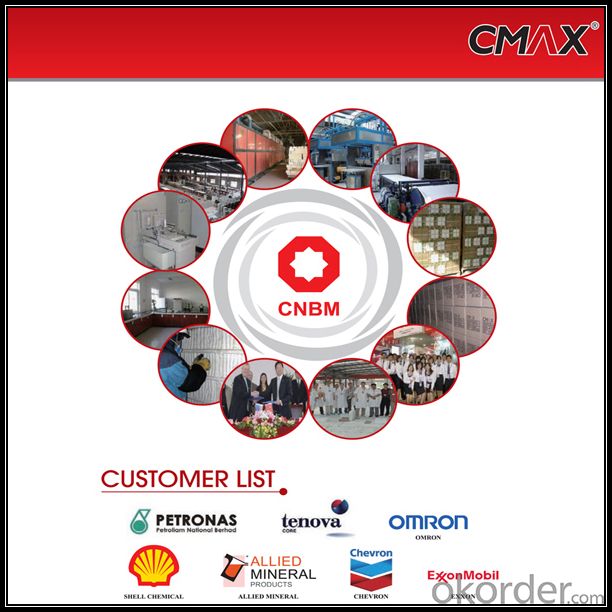
FAQ
1. Which products do you have?
We have all kinds of refractory brick, castable, mortar, cement, ceramic fiber products, etc.
Or you could browse our products to choose what you need.
2. Can you give me a brief introduction of the application of your products?
We are mainly specializing in the refractory materials in iron and steel, cement, glass, ceramics, petrochemical, electric power Industry, etc.
3. If I need your offer, what information do you need?
In order to choose suitable products, it will be appreciated to provide us the information, such us specification, technical data, order quantity, products application etc. If any question, please contact us freely.
- Q: How do insulating fire bricks affect the overall fire safety of a structure?
- Insulating fire bricks play a crucial role in enhancing the overall fire safety of a structure. These bricks are designed to withstand high temperatures and provide excellent insulation, making them an ideal choice for applications where heat containment is necessary. By effectively insulating the structure, these bricks help in minimizing the spread of fire and heat transfer. Their low thermal conductivity helps to slow down the rate at which heat is conducted through the walls, ceiling, and floors of a building. This property is particularly important in preventing the fire from spreading to adjacent areas or neighboring structures. Insulating fire bricks also contribute to the fire safety of a structure by acting as a barrier to the penetration of flames and hot gases. Their ability to withstand high temperatures without compromising their structural integrity allows them to effectively contain the fire within a confined area. This containment prevents the fire from rapidly escalating and provides valuable time for evacuation or firefighting efforts. Furthermore, insulating fire bricks are known for their excellent fire resistance properties. They are manufactured using refractory materials that can withstand extremely high temperatures without melting or disintegrating. This resistance to heat ensures that the bricks maintain their structural integrity even under intense fire conditions, thereby providing a reliable fire protection barrier. In addition to their fire resistance properties, insulating fire bricks also possess excellent insulation capabilities. They have low thermal conductivity, which means they are great at preventing heat transfer. By reducing the rate of heat transfer, these bricks help in maintaining a cooler temperature on the non-fire side. This is particularly beneficial for structures that require temperature control, such as industrial furnaces or kilns. Overall, insulating fire bricks greatly enhance the fire safety of a structure by minimizing the spread of fire, acting as a barrier to flames and hot gases, and withstanding high temperatures without compromising their integrity. Their insulation properties also contribute to maintaining a cooler environment on the non-fire side. Therefore, incorporating insulating fire bricks into the construction of a building significantly improves its ability to withstand and contain fires, ultimately ensuring the safety of occupants and reducing property damage.
- Q: Can insulating fire bricks be used for insulation in chemical reactors?
- Yes, insulating fire bricks can be used for insulation in chemical reactors. Insulating fire bricks are made from lightweight materials such as vermiculite or perlite, which have excellent thermal insulation properties. These bricks are designed to withstand high temperatures and can provide insulation in a variety of applications, including chemical reactors. Chemical reactors often operate at elevated temperatures, and maintaining a stable temperature is crucial for efficient and safe operation. By using insulating fire bricks as insulation in chemical reactors, heat loss can be minimized, leading to better energy efficiency and cost savings. Additionally, insulating fire bricks can help to reduce the temperature gradient within the reactor, ensuring uniform heat distribution and enhancing the overall performance of the reactor. Furthermore, insulating fire bricks are resistant to chemical attack and can withstand the corrosive effects of various chemicals used in chemical reactions. This makes them suitable for use in chemical reactors where exposure to corrosive substances is common. In summary, insulating fire bricks are an excellent choice for insulation in chemical reactors. They provide superior thermal insulation, can withstand high temperatures, and are resistant to chemical attack. Using insulating fire bricks in chemical reactors can contribute to improved energy efficiency, temperature stability, and overall performance of the reactor.
- Q: Are insulating fire bricks suitable for use in incinerators?
- Indeed, insulating fire bricks are well-suited for utilization in incinerators. Tailored specifically to endure elevated temperatures and offer exceptional insulation qualities, these bricks prove to be ideal for incinerators. They exhibit remarkable resistance to thermal shock, ensuring their structural integrity remains intact even under extreme heat exposure. Moreover, these bricks possess low thermal conductivity, which aids in diminishing heat loss and enhancing the overall energy efficiency of the incinerator. The combination of their heat endurance and insulation effectiveness renders them a dependable option for incinerator utilization.
- Q: Are insulating fire bricks suitable for use in the construction of incinerators?
- Yes, insulating fire bricks are suitable for use in the construction of incinerators. Insulating fire bricks have excellent thermal insulation properties, allowing them to withstand high temperatures and efficiently retain heat. This makes them ideal for lining the walls and floors of incinerators, as they help to contain and direct heat, ensuring proper combustion while reducing heat loss. Additionally, insulating fire bricks are resistant to chemical attacks and can withstand the corrosive environment found in incinerators, making them a reliable choice for this application.
- Q: Are insulating fire bricks resistant to mold or mildew?
- Insulating fire bricks do not have resistance to mold or mildew. These bricks are made to withstand high temperatures and provide insulation, but they do not naturally prevent mold or mildew growth. If exposed to moisture or dampness, mold and mildew can still develop on the surface of these bricks. To avoid mold or mildew, it is crucial to keep the bricks dry and well-ventilated. Regular cleaning and maintenance can also be effective in preventing mold or mildew growth on the bricks.
- Q: Are insulating fire bricks suitable for insulation in chemical reactors?
- Due to their exceptional thermal properties and resistance to high temperatures, insulating fire bricks are commonly employed for insulation in chemical reactors. These bricks, which are manufactured from lightweight refractory materials like alumina, silica, and other minerals, effectively impede heat transfer and provide insulation. Furthermore, they possess low thermal conductivity and high heat capacity, enabling them to minimize heat loss and maintain consistent temperatures within the reactor. Chemical reactors often operate at elevated temperatures and may contain corrosive or reactive substances. Insulating fire bricks can withstand these harsh conditions and safeguard the reactor against external heat sources. They are chemically inert and corrosion-resistant, making them suitable for use with various chemicals and reactants. Additionally, insulating fire bricks exhibit a low thermal expansion coefficient, allowing them to endure thermal cycling without cracking or distorting. This characteristic is crucial in chemical reactors where temperature fluctuations are frequent and can potentially harm the equipment. In conclusion, insulating fire bricks are a popular choice for insulation in chemical reactors due to their thermal insulation properties, resistance to chemicals, and ability to withstand high temperatures and thermal cycling. Their usage aids in enhancing the efficiency and safety of chemical processes by maintaining optimal operating conditions within the reactor.
- Q: Can insulating fire bricks be used in the insulation of boilers?
- Indeed, the utilization of insulating fire bricks is possible for the insulation of boilers. These fire bricks are engineered to endure elevated temperatures and exhibit remarkable efficiency in preventing heat transfer. With their low thermal conductivity, they aid in minimizing heat dissipation from the boiler, thereby enhancing its energy efficiency holistically. Moreover, due to their lightweight composition and ease of installation, insulating fire bricks are an optimal selection for boiler insulation.
- Q: What is the maximum temperature that insulating fire bricks can withstand?
- Insulating fire bricks can withstand temperatures up to 3000°F (1650°C).
- Q: Can insulating fire bricks be used in the construction of cremation chambers?
- Insulating fire bricks have the capability to be utilized in the construction of cremation chambers. These bricks are manufactured using lightweight materials such as vermiculite or perlite, which possess remarkable insulating properties. These properties render them suitable for high-temperature applications like cremation chambers, where they are instrumental in maintaining a consistent and controlled temperature. The utilization of insulating fire bricks in the construction of cremation chambers yields numerous benefits. Firstly, these bricks aid in enhancing energy efficiency by minimizing heat loss. This subsequently leads to reduced fuel consumption and cost savings. Secondly, the insulating properties of these bricks ensure that a stable temperature is maintained within the cremation chamber, which is crucial for achieving efficient and complete combustion of the deceased. Furthermore, these bricks are lightweight and easy to handle, thereby facilitating a more convenient and efficient construction process. Nevertheless, it is worth noting that although insulating fire bricks can be employed in the construction of cremation chambers, they are typically used in conjunction with refractory fire bricks. Refractory fire bricks are fabricated from materials such as clay or silica, which possess the ability to withstand exceedingly high temperatures. These bricks are installed in areas of the cremation chamber that come into direct contact with the flames, while insulating fire bricks are utilized in areas that require insulation. In conclusion, insulating fire bricks are a suitable choice for the construction of cremation chambers due to their excellent thermal insulation properties and ability to contribute to the efficient and controlled operation of the cremation process.
- Q: Is it possible to cut insulating fire bricks to fit custom shapes?
- Yes, it is possible to cut insulating fire bricks to fit custom shapes. Insulating fire bricks are made from lightweight materials such as ceramic fiber, which can be easily cut or shaped using various tools. Common methods for cutting insulating fire bricks include using a saw, knife, or even a hot wire cutter. It is important to follow proper safety precautions and wear protective gear when cutting these bricks, as the cutting process may produce dust or sharp edges. With the right tools and techniques, it is possible to cut insulating fire bricks to fit any desired custom shape.
Send your message to us
Insulating Fire Brick High Alumina Brick for Pizza Oven
- Loading Port:
- China main port
- Payment Terms:
- TT OR LC
- Min Order Qty:
- 2 m.t
- Supply Capability:
- 1000 m.t/month
OKorder Service Pledge
OKorder Financial Service
Similar products
Hot products
Hot Searches
Related keywords
